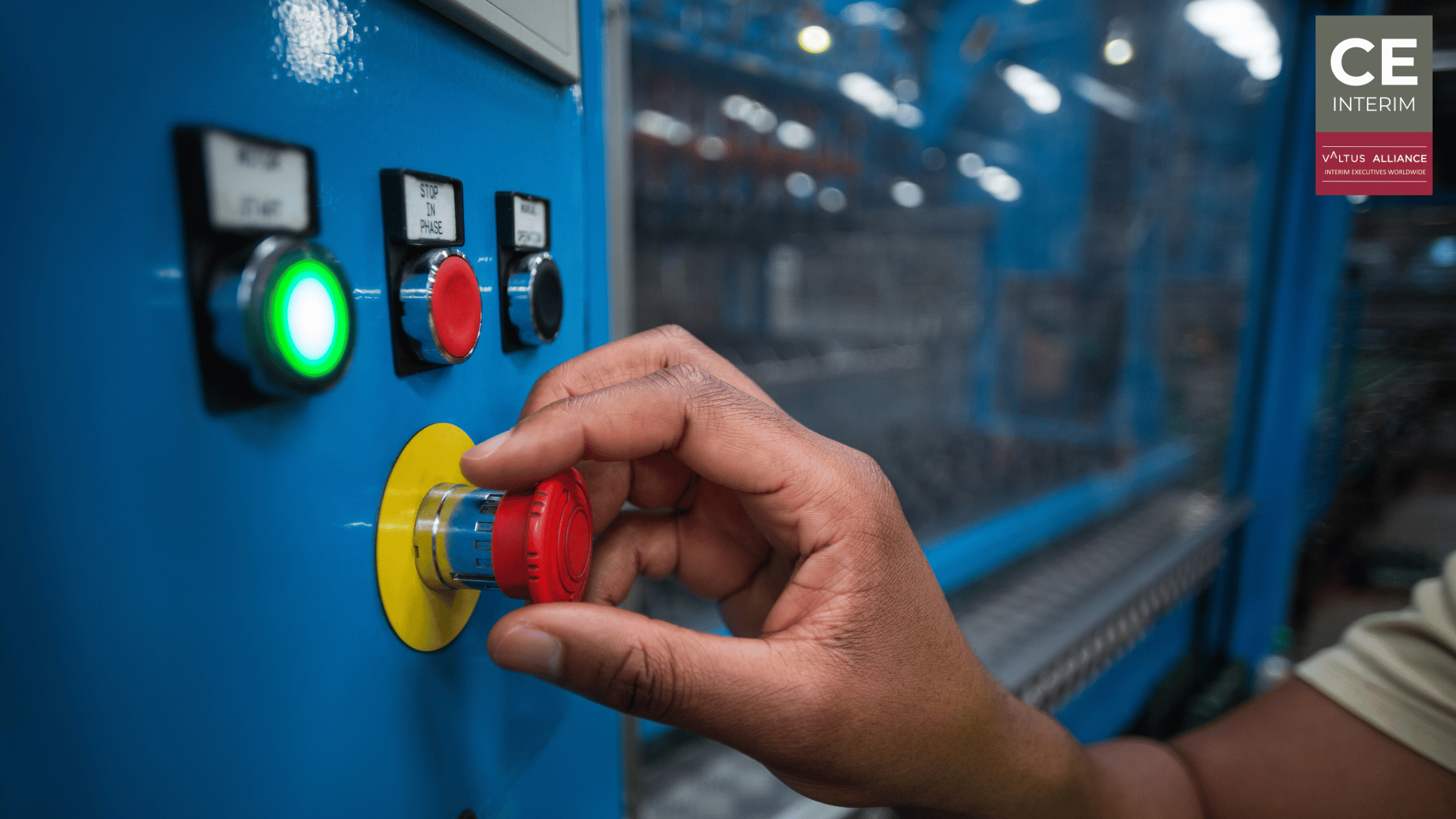Not enough time to read the full article? Listen to the summary in 2 minutes.
Bosch plans to stop production at two Power Tools plants in Germany by late 2026: Sebnitz in Saxony and Leinfelden-Echterdingen near Stuttgart. About 500–510 jobs are affected. Production will shift into Bosch’s wider network, including Central and Eastern Europe.
The headline is about jobs, yet the real story for owners and boards is execution. A small interim COO with a project office can keep customers supplied, suppliers paid, and banks relaxed while the move happens.
The facts: sites, dates, headcount, product lines
Sebnitz, Saxony
Sebnitz is a precision assembly site with roughly 280 people. It supports tools and garden equipment in smaller series. The factory anchors local suppliers, logistics firms, and services in the town.
When a site like this closes, the impact spreads across that local web, not only across the payroll.
Leinfelden-Echterdingen, Baden-Württemberg
This plant sits close to Power Tools headquarters. Around 230 roles are in scope across production and support. Even if some indirect roles remain, the core value creation moves. That changes how new models are qualified, how suppliers are chosen, and where leadership attention sits.
Why now: demand, price pressure, and idle capacity
Germany’s construction market has cooled, so demand for many tool lines softened. Prices are tight, fixed costs are high, and lines are not full. In that mix, global manufacturers push work to larger, lower-cost hubs that can stay busy. That is the logic here.
There is a wider pattern in German industry. When a site no longer wins the investment needed for new products and automation, it slowly slips off the roadmap. The question becomes less “if” and more “when” and “where to.”
Beyond jobs: who is exposed and how
I. Customers and distributors
Customers care about deliveries and service. The risk is not that products disappear, it is that the move creates short delays, allocation, or confusion about service and spares. Clear, consistent dates and a single point of contact help.
A neutral interim program lead can keep the plan and the messages aligned.
II. Tier-2 and tier-3 suppliers
As volume moves to Central and Eastern Europe, orders for castings, plastics, packaging, and sub-assemblies follow. German SMEs with a high Bosch mix can feel pressure on cash as schedules shift. Some will be asked to dual-supply, others to qualify new hubs.
An interim supply-chain lead can fast-track trials, bookings, and first-article approvals.
III. Banks and creditors
Banks want proof that the business is under control. They expect a short, factual pack that shows run-out, ramp-up, buffers, and risks. Many owners prefer a temporary independent executive to front these updates so the conversation stays calm and simple.
IV. Municipalities
Towns need a path from exit to reuse. Sites are often suitable for other industrial activity. Early, credible reuse plans help attract replacement employers and support local morale.
Where production goes: Hungary and the CEE manufacturing arc
Production from Sebnitz and Leinfelden-Echterdingen is expected to move into Bosch’s network, including Hungary. Quality does not need to suffer. What changes is the workflow. Tooling is moved, lines are validated, and transport routes are updated.
There is often a period of dual running so customers do not feel the change.
In similar moves, CE Interim sets a small project office to coordinate tooling, trials, lab tests, and transport slots so dates hold.
What changes for buyers
- Lead times may flex during line validation.
- Labels or country-of-origin markings can change.
- Warranty and service should remain stable, but need clear signposting.
- Temporary allocation is possible while new capacity ramps.
If you are exposed: immediate checks by role
I. Owners and boards.
Stand up a cross-functional project office with a weekly rhythm, led by an interim COO who is outside day-to-day politics. Map exposure by SKU, plant, supplier, and customer. Approve a short list of actions and follow them tightly.
II. Procurement and operations.
Confirm dual sourcing where it exists. Build a small inventory bridge for top movers. Qualify new lines early with pilot lots. Book transport to new hubs in advance.
III. Sales and account teams.
Call key customers now. Share honest timelines, swap-in alternatives, and clear service flows. Protect relationships.
IV. Finance and lenders.
Run a 13-week cash view. Report on deliveries, backlogs, and customer risk. Keep a compact evidence pack ready for covenant talks.
V. HSE and quality.
Align on process capability at the receiving plant, sample sizes for first articles, and a short list of critical features.
These basics cost less than a broken quarter.
Germany execution pitfalls leaders underestimate
Works councils and social plans
Works councils have real consultation rights when operations change. Social plans are often negotiated to support employees. The order of steps and the quality of documents matter. Teams get into trouble when notices are rushed or the business case is thin.
An interim project lead keeps the file clean, the calendar realistic, and the tone professional.
Collective redundancies, timing, and filings
When dismissals cross set thresholds in a period, the employment agency must be notified. The content and timing of filings affect whether terminations stand up later. Counsel guides the law, the project team owns the dates, data, and communication plan.
An interim HR program manager removes guesswork.
Operational change duties
Larger establishments must consult when there is a significant operational change. Think of this as part of the project plan. Attempting to implement before talks are concluded can add weeks. Treat it as a milestone with owners and buffers.
The 30–100 day control plan owners use to stay in control
Day 0–30: Stabilise
- Appoint an interim COO and a small project office that reports weekly to the board.
- Map at-risk SKUs and customers. Add temporary buffers where pain will show first.
- Align one message for customers, suppliers, and banks.
- Build a live dashboard that tracks deliveries, backlogs, supplier status, and cash.
Day 31–100: Execute
- Move or re-source lines with disciplined trials and first-article approval.
- Run works-council and redundancy steps with proper records and a clear timetable.
- Lock transport and shift safety stocks to the right places.
- Close the loop with customers who got allocation or substitutions.
- Keep lenders updated with a short evidence pack and a forward view of recovery.
This plan reduces noise and makes accountability visible without adding heavy bureaucracy.
What to track weekly: the dashboard that keeps everyone calm
- On time, in full on the affected SKUs.
- Backlog age and the rate at which it is clearing.
- Supplier heat map with green, amber, red status.
- First-article approvals and defects per million on new lines.
- Inventory bridge in days for the top 50 SKUs.
- Customer churn risk for top accounts.
- Cash runway and any covenant headroom.
- Critical path tasks with owners and dates.
The interim project office owns the dashboard so everyone works from one version of the truth.
Outlook through 2026: what could change next
Moves like this rarely close the story. Tool demand follows renovation, new builds, and consumer confidence. Even if the German construction market steadies, network choices are unlikely to be reversed.
Expect more supplier work to follow into Central and Eastern Europe, more automation at German sites that remain, and a shift in jobs from assembly to engineering, software, and service.
There is a broader pattern to watch. When large manufacturers rebalance, regional SMEs must decide if they follow, pivot, or consolidate. Owners who install temporary, independent leadership early, share honest timelines, and execute cleanly will keep customers and banks on side.
Quiet help if you need it
If your business is directly exposed or you want a neutral operator to run the transition, CE Interim can embed leadership quickly, set up the project office, stabilise supply, and hand back a steady run rate. Start with a short, private assessment and a 30-day plan.





